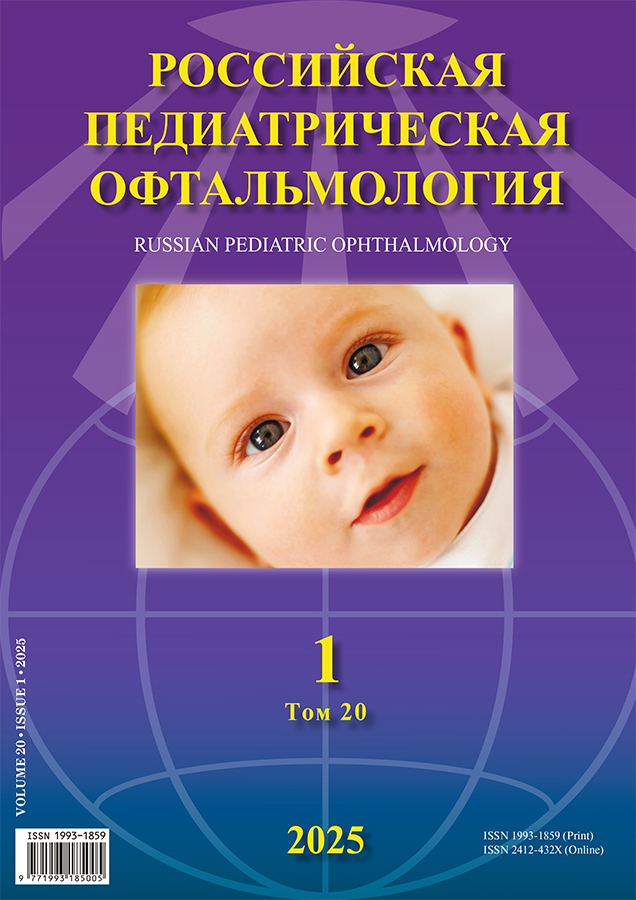Medical and social aspects of pediatric lens pathology
- Authors: Khamraeva L.S.1
-
Affiliations:
- Tashkent Pediatric Medical Institute
- Issue: Vol 20, No 1 (2025)
- Pages: 27-34
- Section: Original study article
- Published: 29.04.2025
- URL: https://ruspoj.com/1993-1859/article/view/646556
- DOI: https://doi.org/10.17816/rpoj646556
- EDN: https://elibrary.ru/XGPGZB
- ID: 646556
Cite item
Abstract
AIM: To examine the medical and social aspects of pediatric lens pathology based on clinical data from the Tashkent Pediatric Medical Institute (TashPMI). Objectives: To analyze the disease distribution and regional profile as well as the social aspects of pediatric lens pathology; determine the timing of cataract diagnosis and treatment, including healthcare professionals and facilities involved in the diagnosis; identify the factors contributing to delayed treatment of pediatric lens pathology, and propose strategies for improvement.
MATERIAL AND METHODS: A retrospective review of medical records was performed for 165 patients (249 eyes) with lens pathology.
RESULTS: According to clinical data from TashPMI, lens pathology in children was predominantly represented by congenital cataracts (81.2%), post-contusion traumatic cataracts (15.2%), and post-uveitis complicated cataracts (3.6%). The majority of cases were observed in boys (62.4%) aged 6 months to 15 years. The highest frequency of cases was observed among children residing in Tashkent, rural areas near the capital, and the southern regions of Uzbekistan. Among patients with lens pathology, 90.2% of fathers and 94.6% of mothers had secondary or vocational education. Some parents (17.6%) were diagnosed with visual disability, and all of them were parents of children with congenital cataracts. Every fifth child with lens pathology was born to consanguineous parents. Cataracts were most often first diagnosed in primary healthcare settings (61.8%), typically at rural health posts in the patients’ communities. The primary reason for delayed surgical treatment of cataracts was contraindications to intubation anesthesia due to comorbidities (43%).
CONCLUSION: Monitoring of the medical and social aspects of pediatric lens pathology not only facilitates the identification of factors that hinder timely diagnosis and treatment but also shapes patient management strategies based on these factors.
Full Text
About the authors
Lola S. Khamraeva
Tashkent Pediatric Medical Institute
Author for correspondence.
Email: lola251167@mail.ru
ORCID iD: 0000-0003-0221-702X
MD, Cand. Sci. (Medicine)
Uzbekistan, TashkentReferences
- Somov EE. Selected sections of paediatric clinical ophthalmology. Saint Petersburg: Chelovek; 2016. P. 199–207. (In Russ.)
- Kabylbekova AK, Aringazina AM, Auezova AM, Meirmanov SK. Epidemiological characteristics of congenital cataract. Literature review. Science and healthcare. 2022;24(3):219–226. doi: 10.34689/SH.2022.24.3.025 EDN: XERPQI
- Khamraeva L, Narzullayeva DU. On the structure of eye diseases in children leading to blindness or low vision in various countries of the world. Russian ophthalmological journal. 2023;16(4):165–169. doi: 10.21516/2072-0076-2023-16-4-165-169 EDN: IOHSHR
- Bobrova NF, Dembovetskaya AN, Zhekov AK. Traumatic cataracts of children’’s age. Secrets of endocapsular implantation. Russian ophthalmology of children. 2013;(4):13–17. EDN: RTHXPX
- Drozdova EA. Medical management of uveal cataract surgery. Effective pharmacotherapy. Effective pharmacotherapy. 2012;(38):16–19. (In Russ.) EDN: SKFWOP
- Pisarevskiy SL. Congenital cataract as a cause of blindness and low vision in students of boarding schools for blind and visually impaired children. Medical journal of Uzbekistan. 1989;(4):14–16. (In Russ.)
- Khamraeva LS, Khamroeva YA, Khamidova ShN. Socially significant eye diseases in children. Bulletin of the Tashkent Medical Academy. 2022;(6):155–157. (In Russ.)
- Bilalov EN, Narzikulova KI, Ochildiev MB, Nazirova SH. The prevalence of certain types of hereditary eye diseases in the Surkhandarya region. Advanced ophthalmology. 2023;1(1):36–40. (In Uzbek) doi: 10.57231/j.ao.2023.1.1.008 EDN: PMFBSL
- Katargina LA, Kruglova TB, Mamykina AS, et al. Clinical and functional characteristics of pseudophakic myopia in children after congenital cataract extraction in infancy. Russian ophthalmological journal. 2022;15(2):24–29. doi: 10.21516/2072-0076-2022-15-2-24-29 EDN: PLRFEX
- Khamraeva LS, Latipova NH, Narzullayeva DU. Clinical efficacy of individual intraocular lens calculation in children with congenital cataract at risk of abnormal refraction. Russian ophthalmological journal. 2023;16(1):101–106. doi: 10.21516/2072-0076-2023-16-1-101-106 EDN: VSIMFA
- Patent for invention No. IAP 7783 dated 08/05/2024 Ministry of Justice of the Republic of Uzbekistan. Khamraeva LS, Narzullayeva DU. A method for determining the optical strength of an intraocular lens in children with congenital cataracts. (In Uzbek.) Available from: https://im.adliya.uz/publications/ONE/2024/8?document=d7abe32e-0042-4466-ac65-f0cf2a2f3c3f
- Katargina LA, editor. Paediatric ophthalmology. Federal clinical recommendations. Moscow: GEOTAR-Media; 2016. P. 57–77. (In Russ.)
Supplementary files








